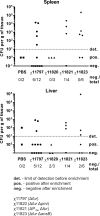Evaluation of protective efficacy of live attenuated Salmonella enterica serovar Gallinarum vaccine strains against fowl typhoid in chickens
- PMID: 24990908
- PMCID: PMC4178578
- DOI: 10.1128/CVI.00310-14
Evaluation of protective efficacy of live attenuated Salmonella enterica serovar Gallinarum vaccine strains against fowl typhoid in chickens
Abstract
Salmonella enterica serovar Gallinarum is the etiological agent of fowl typhoid, which constitutes a considerable economic problem for poultry growers in developing countries. The vaccination of chickens seems to be the most effective strategy to control the disease in those areas. We constructed S. Gallinarum strains with a deletion of the global regulatory gene fur and evaluated their virulence and protective efficacy in Rhode Island Red chicks and Brown Leghorn layers. The fur deletion mutant was avirulent and, when delivered orally to chicks, elicited excellent protection against lethal S. Gallinarum challenge. It was not as effective when given orally to older birds, although it was highly immunogenic when delivered by intramuscular injection. We also examined the effect of a pmi mutant and a combination of fur deletions with mutations in the pmi and rfaH genes, which affect O-antigen synthesis, and ansB, whose product inhibits host T-cell responses. The S. Gallinarum Δpmi mutant was only partially attenuated, and the ΔansB mutant was fully virulent. The Δfur Δpmi and Δfur ΔansB double mutants were attenuated but not protective when delivered orally to the chicks. However, a Δpmi Δfur strain was highly immunogenic when administered intramuscularly. All together, our results show that the fur gene is essential for the virulence of S. Gallinarum, and the fur mutant is effective as a live recombinant vaccine against fowl typhoid.
Copyright © 2014, American Society for Microbiology. All Rights Reserved.
Figures


Similar articles
-
Safety and protective efficacy of live attenuated Salmonella Gallinarum mutants in Rhode Island Red chickens.Vaccine. 2013 Feb 4;31(7):1094-9. doi: 10.1016/j.vaccine.2012.12.021. Epub 2012 Dec 20. Vaccine. 2013. PMID: 23261043
-
Immune response induced by ppGpp-defective Salmonella enterica serovar Gallinarum in chickens.J Microbiol. 2010 Oct;48(5):674-81. doi: 10.1007/s12275-010-0179-6. Epub 2010 Nov 3. J Microbiol. 2010. PMID: 21046347
-
Evaluation of the Salmonella enterica Serovar Pullorum Pathogenicity Island 2 Mutant as a Candidate Live Attenuated Oral Vaccine.Clin Vaccine Immunol. 2015 Jul;22(7):706-10. doi: 10.1128/CVI.00130-15. Epub 2015 Apr 29. Clin Vaccine Immunol. 2015. PMID: 25924763 Free PMC article.
-
Salmonella enterica serovar Gallinarum: addressing fundamental questions in bacteriology sixty years on from the 9R vaccine.Avian Pathol. 2017 Apr;46(2):119-124. doi: 10.1080/03079457.2016.1240866. Epub 2017 Jan 30. Avian Pathol. 2017. PMID: 27791403 Review.
-
Immunity and Protection Provided by Live Modified Vaccines Against Paratyphoid Salmonella in Poultry-An Applied Perspective.Avian Dis. 2021 Jun;65(2):295-302. doi: 10.1637/aviandiseases-D-20-00126. Avian Dis. 2021. PMID: 34412461 Review.
Cited by
-
Salmonella enterica Serovar Gallinarum Biovars Pullorum and Gallinarum in Poultry: Review of Pathogenesis, Antibiotic Resistance, Diagnosis and Control in the Genomic Era.Antibiotics (Basel). 2023 Dec 25;13(1):23. doi: 10.3390/antibiotics13010023. Antibiotics (Basel). 2023. PMID: 38247582 Free PMC article. Review.
-
Vaccination with a ΔnorD ΔznuA Brucella abortus mutant confers potent protection against virulent challenge.Vaccine. 2016 Oct 17;34(44):5290-5297. doi: 10.1016/j.vaccine.2016.09.004. Epub 2016 Sep 14. Vaccine. 2016. PMID: 27639282 Free PMC article.
-
Genetic engineering of Salmonella spp. for novel vaccine strategies and therapeutics.EcoSal Plus. 2024 Dec 12;12(1):eesp00042023. doi: 10.1128/ecosalplus.esp-0004-2023. Epub 2024 Jul 18. EcoSal Plus. 2024. PMID: 39023252 Free PMC article. Review.
-
Salmonella pathogenicity island-14 is a critical virulence factor responsible for systemic infection in chickens caused by Salmonella gallinarum.Front Vet Sci. 2024 May 23;11:1401392. doi: 10.3389/fvets.2024.1401392. eCollection 2024. Front Vet Sci. 2024. PMID: 38846788 Free PMC article.
-
Attenuated mutants of Salmonella enterica Typhimurium mediate melanoma regression via an immune response.Exp Biol Med (Maywood). 2024 Jun 21;249:10081. doi: 10.3389/ebm.2024.10081. eCollection 2024. Exp Biol Med (Maywood). 2024. PMID: 38974834 Free PMC article.
References
-
- Shivaprasad HL. 2000. Fowl typhoid and pullorum disease. Rev. Sci. Tech. 19:405–424 - PubMed
Publication types
MeSH terms
Substances
Grants and funding
LinkOut - more resources
Full Text Sources
Other Literature Sources

